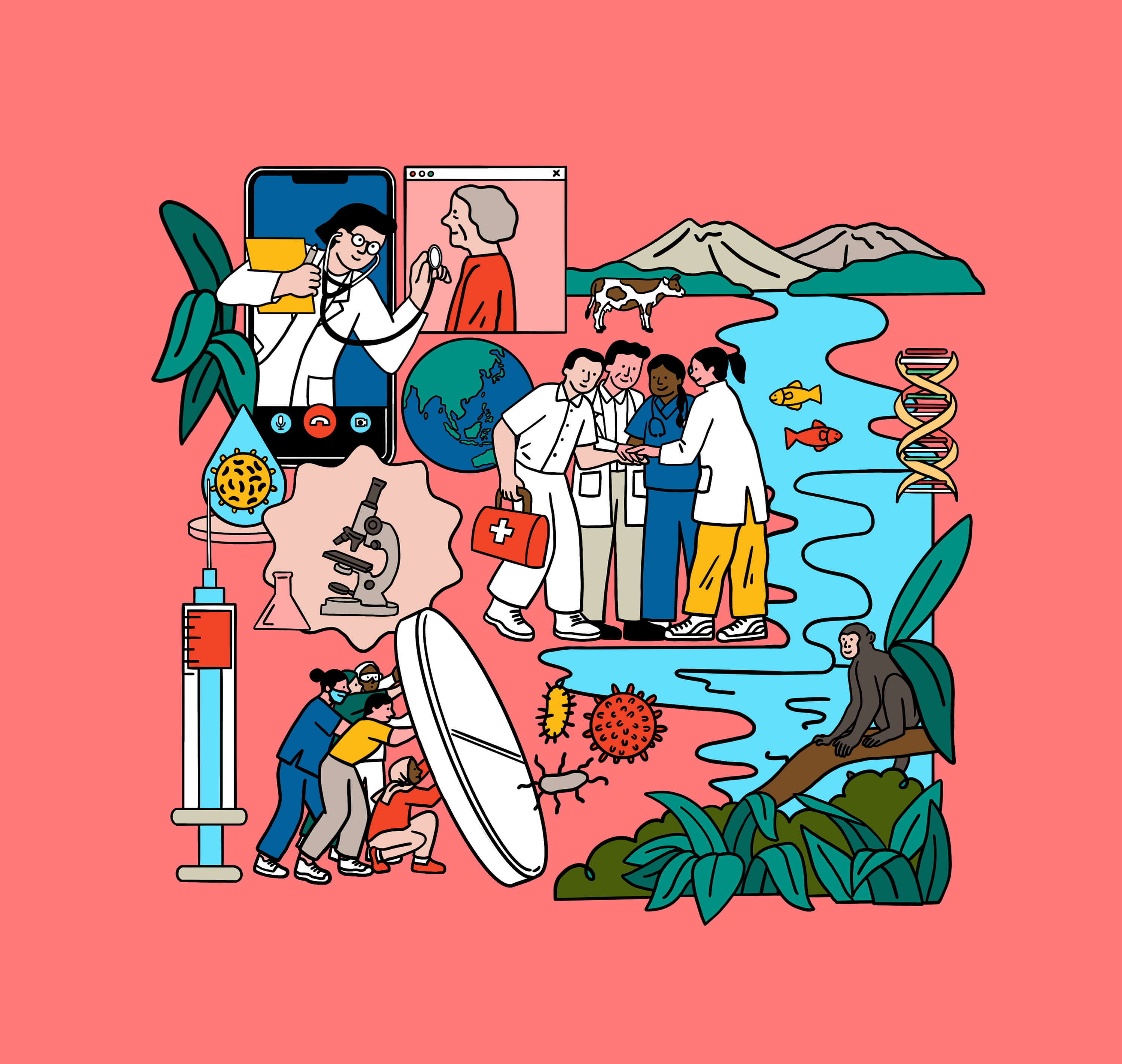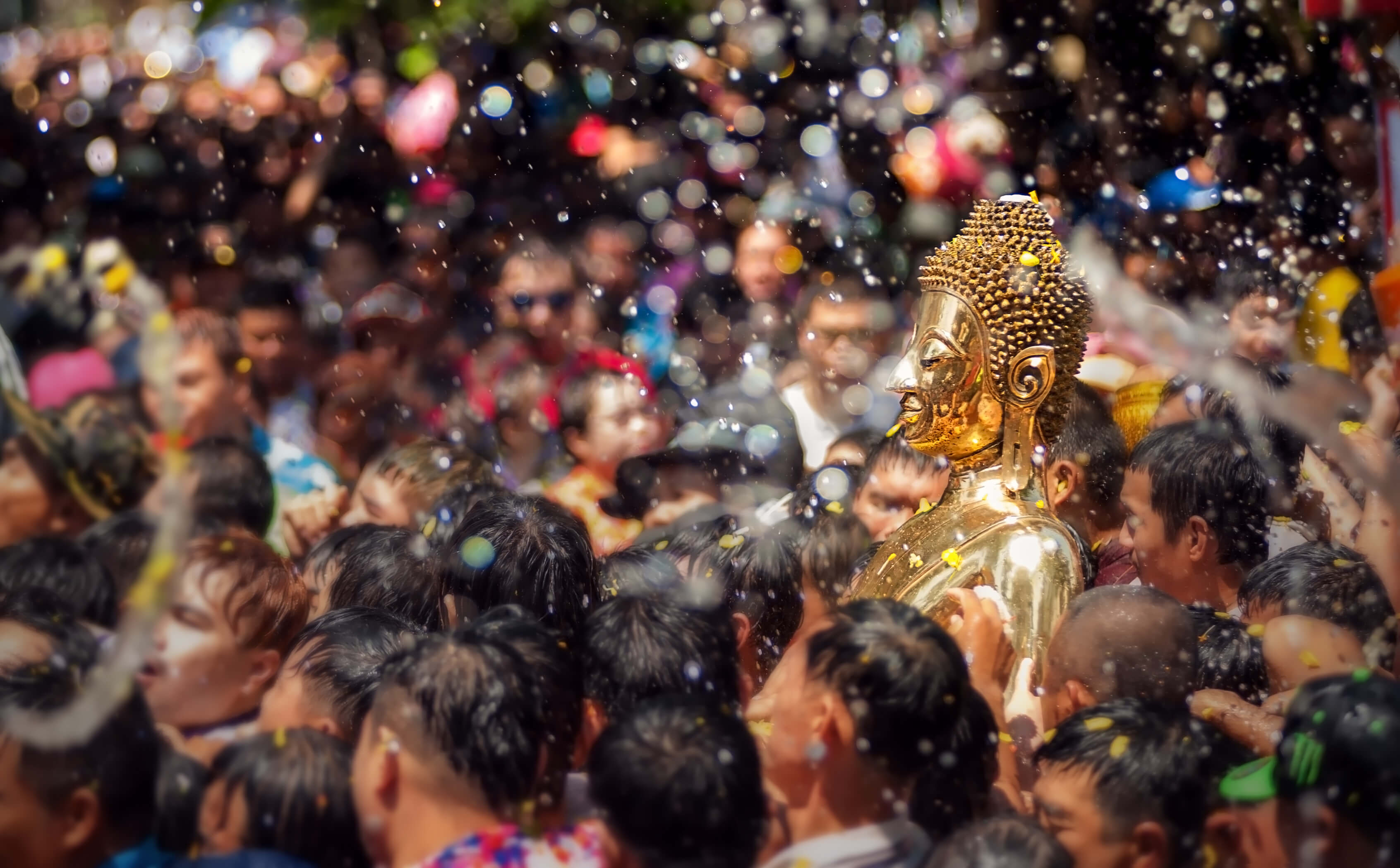




Water and rain are essential to sustaining lives and livelihood, and fostering social and economic development throughout Southeast Asia. They are, for example, necessary for the production of rice, a tradition that dates back to thousands of years. Rice has remained an important commodity in the region, both as a staple food and an export product. Almost 30 per cent of the world’s rice-growing areas are situated in the region, with Thailand and Viet Nam ranking among the top global rice exporters (International Rice Research Institute, n.d.). This is largely due to the interplay between water resources, land, and the ecosystem.
The region’s dependence on water resources has given rise to a variety of practices and rituals that embody narratives about people’s relationships with nature and the spiritual world.
One such traditional rainmaking ritual is the Hae Nang Maew Ceremony (Cat Parading Ceremony), which is practiced by Thai farmers in both the central and northeast region of the country. Farmers parade the nang maew (cat) around their villages or temples when the planting season approaches, hoping for rain when it is most needed. It is believed that cats are animals scared of rain, and if a cat cries out during the ceremony, it means that rain is imminent.
Another important tradition, known as Bun Bang Fai (Rocket Festival), is practised in the Lao PDR and north eastern Thailand every June, just before the farming season. During this festival, villagers, and monks gather to make rockets, either from bamboo or iron pipes, with some weighing 100 to 120 kilograms each. The festivities include a procession around the temple or other nearby areas, before people launch rockets into the sky. This act serves as an offering to the god called “Phraya Thaen,” who is believed to be responsible for ensuring that the rain falls according to the season.
Indonesia, meanwhile, has the Kebo-Keboan Traditional Ceremony, which has long been practised by Banyuwangi people in the Aliyan and Alasmalang villages of East Java. The ceremony is performed to plead for rain, good harvests, and protection against disasters during the dry season. The villagers believe that adhering to this tradition symbolises their gratitude for the grace of God and invokes the ancestral spirits to grant their wishes.
Buffaloes are seen as the key symbol for this traditional ceremony since they are closely associated with farmers’ activities and rice fields. During the ceremony, individuals dress up and role-play as buffaloes (kebo), as no real animals are involved. The ceremony begins with prayers and eating of tumpeng, a dish of 12 cone-shaped mounds of rice that represent the cycle of life. The event brings together elders, community leaders, officials, and villagers, who all join a procession along the irrigation dams to witness the water flowing into the rice fields.
Beliefs associated with negotiating for rain and cultural practices, which are related to upholding order and harmony within the community, have always been integral aspects of these ceremonies. While some of these customs and beliefs have been preserved over time and are still practised today, they face a number of challenges, such as climate change.
Climate change has disrupted the predictability of rainfall. Rain now falls at irregular intervals and not in accordance with the expected seasons. As a result, some areas experience excessive rainfall while other areas suffer from droughts. Hence, farmers have difficulty regulating water for crop production, causing shortages of agricultural products supplied to the markets.
Another consequence of climate change is the rising of sea levels. This phenomenon will also negatively impact agricultural production, lead to soil salinisation, and compromise food and water security. Crop productivity in coastal and small island communities will likely decrease and affect nutritional health, small farm incomes, ecosystem cycles, and food price stability. Additionally, rising sea levels increase the risk of storms and flooding during coastal storm events. Unpredictable weather poses challenges to the observance of rain-related traditions, as they can no longer be carried out during the typical wet seasons. These conditions raise the possibility of the disappearance of these cultural practices.
According to the Global Climate Risk Index, four out of 10 of the countries most affected by climate change due to global warming are ASEAN Member States. These include Myanmar, the Philippines, Thailand and Viet Nam. In addition, a study by the Asian Development Bank found that the region is experiencing rising temperature and sea levels. The average annual temperature is likely to increase by approximately 1°C (3.7 per cent) across the region, and sea levels have risen by 61 per cent, with a notable increase from an average of 2.6 mm/year during 1993-2008 to 4.2 mm/year during 2008-2022. These changes have particularly affected coastal nations, with the Philippines, Indonesia, Thailand, and Viet Nam being significantly impacted.

Over the past five years, the region has experienced the severest droughts recorded in decades. At the peak of these droughts, over 70 per cent of the land area was affected, exposing nearly 60 per cent of the region’s population to this dire situation (Southeast Asia Development Solutions, 2020). Meanwhile, the Weather and Climate Service for ASEAN predicted an increased likelihood of below-normal rainfall during the period of August–October 2023, especially for the southern ASEAN region. The dry season is yet to reach its peak intensity. In addition, the onset of El Niño, which contributes to below-normal rainfall in many parts of the region, raises concerns about the potential for hotspots and haze events in the southern ASEAN region, reaching intensity not seen since 2019 (The Weather and Climate Service for ASEAN, n.d.).
Climate change and extreme weather disruptions are not the only risks to vanishing rain-related customs. Modernity also threatens the continuation of these traditions. Despite initiatives to pass down these customs to the next generation, ritual knowledge has been gradually fading among the elders.
ASEAN has made concerted efforts to raise awareness of the region’s cultural heritage related to rain and the impact of climate change on it. The ASEAN Sub-Committee on Culture (SCI) of the ASEAN Committee of Culture and Information (ASEAN COCI), led by the Ministry of Culture of Thailand, collaborated with the SEAMEO Regional Centre for Archaeology and Fine Arts (SEAMEO SPAFA) to organise “Rain Motions: Connecting (with) the Skies of Southeast Asia.”
This initiative received support from the ASEAN Cultural Fund (ACF). It brought together 21 traditional and contemporary performers and 11 scholars and researchers from the ASEAN Member States and Timor-Leste. It consisted of a series of online workshops from February to April 2023, wherein participants brainstormed concepts for joint performances and how best to convey messages about the region’s rain-related customs. Subsequently, the on-site seminar and joint performance took place in Bangkok, Thailand in May 2023. The initiative provided new perspectives on widely-performed Southeast Asian masked and traditional ethnic dances, while serving as a bridge between the past and present. It addressed urgent concerns posed by climate change, which threaten various aspects of human lives, including their culture and traditions.
Khemchat Thepchai, Center Director of SEAMEO SPAFA, said that the project aimed to promote contemporary dance while preserving cultural and natural heritage in Southeast Asia.
Darunee Thamapodol, advisor to the Ministry of Culture of Thailand, emphasised that the project would foster cross-cultural understanding and facilitate knowledge exchange on environmental conservation and climate change adaptation. She highlighted that these elements, distinct from rain itself, had become deeply ingrained in Southeast Asian cultures. She also underscored the project’s relevance in light of the growing global concern over climate change. The collaborative art performance were selected as effective means to promote the essence of rain.
During the seminar, scholars from ASEAN Member States and Timor-Leste presented their knowledge about cultural heritage, beliefs and traditions associated with rain. The presentations included Adai-Adai Dance by Brunei Darussalam; Temples and Practices by Cambodia; Mapping Indonesia Cultural Assets for Rain Motions by Indonesia; Bun Bang Fai or Rocket Festival by Lao PDR; The Concept of Water in the Kelantanese Shadow Play by Malaysia; Rain and Tug-of-War Traditional Connection with Moe Kaung Kyaw Swar Nat (Spirit) by Myanmar; Tug Of Wa(te)r by the Philippines; Water That Moves Us by Singapore; Rain Culture in Thailand by Thailand; Water-Related Culture in Viet Nam by Viet Nam; and Timorese Tradition and Culture by Timor-Leste.

The performances, presented in three acts (Voices, Negotiation, and Celebration), were witnessed by embassy officials from several ASEAN Member States and Timor-Leste, representatives from the media and the academe, and members of the public.
Chanlyka Leav, a performer from Cambodia, expressed her appreciation for the opportunity to connect with other performers: “It is such a great honour to join this program. What surprised me the most is the big similarity in ASEAN and Timor Leste cultures, how we value our family, our warmth, and our hospitality.”
Meanwhile, Pham Thi Duong, a performer from Viet Nam, said that the programme was important for her to gain more experience and a deeper understanding of the relationship among ASEAN performers, especially those from Timor Leste. “I have been abroad many times to perform, but with this workshop, my first time in Bangkok, I learned a lot about how all ASEAN cultures were connected. We all shared our wonderful rituals and beliefs. I have had a memorable experience on this joyful journey.”
Dr. Kusuma Venzky-Stalling, the artistic director at Chiang Mai University, Thailand, explained the sensitivity of applying the concept of “weaving a tapestry” to bridge traditional and contemporary performing forms during the devising process. “Any adjustment should not destroy the core value of traditions, yet the water/rain-related culture narrative about the interconnection between people and nature must be tastefully told,” she said.
She added: “The most challenging part was what to tell and how to express the idea so that the show could be meaningful, innovative and most importantly, how to create a fresh perspective of how academic knowledge and artistic expression co-existed.” The way that artists chose their artistic expression to voice those beliefs and even questioned the human relationship with nature and the environment in today’s urban life reminded me of the role of performing arts in communicating these concerns.”
Teeradon Kaewklam, a third-year student from Srinakharinwirot University of Thailand and one of the audience members, found ASEAN’s diverse cultures fascinating and was awed by their co-existence and similarities. He remarked, “Although we are different nations, we use different languages and believe in different religions, we live in the same region and have access to water to connect with everyone. After the show, I couldn’t say anything because the show touched my heart.”







